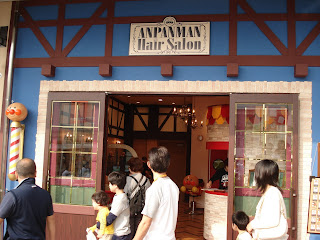
In Japan, if you have young children around, Anpanman is likely to be a household name. Anpanman is a famous cartoon superhero in Japan among young children, created by a man named Takashi Yanase. Markus has taken a liking to Anpanman, so we wanted to treat him to a well-deserved visit to the museum. He learned many of the theme songs and dances from Jidokan. Upon arrival, it was no surprise to find a long line-up at the entrance. The new museum had first opened in April, and we were sure that the novelty had not worn out in the slightest. Markus was being patient while listening to the familiar Anpanman songs that played over the speakers, though it triggered his excitement even more.

So what's all the hype about? In my opinion, it's a tad bizarre. He's not just the average flying, cape-wearing superhero. He is made of bread. Yes, in fact, his head is filled with sweet been paste, a popular Japanese pastry called anpan, thus the name Anpanman. His premise is to fight for justice and to save the world. Anpanman also sacrifices himself in each episode of the cartoon. For instance, to save a poor, starving boy, he will take a chunk off of his own head and feed it to the boy. At that point, he becomes weak and his powers are diminished, therefore he must return to his father, Jamu Ojisan (Uncle Jam) the baker, who bakes him a new head, by which he is then revitalized. The children just adore Anpanman!

Besides Anpanman, Markus' other favourite character is Baikinman (Germ Man). He plays a villain in the cartoon. The purple prop on the right is Baikinman's aircraft.
Since the inception of the television cartoon in 1988, over a thousand different characters have been introduced. Markus is familiar with the names of eight characters.
The three-story museum was unbelievable. Besides the many galleries to observe and fun games to play within, there is also a shopping mall complete with an Anpanman-themed hair salon, book/video store, restaurant, bakery, and of course a gargantuan souvenir shop. Prices for the paraphernalia were outrageous! I thought it was interesting to learn that an Anpanman helium balloon cost nearly 400 yen (approx. $4 US) more than a Disney character helium balloon sold in Tokyo Disneyland. The attendant selling the Anpanman balloons could barely keep his stock full! Let's just say that Yanase-san hit the jackpot in a major way with this creation!

Everyone rushed Anpanman as he made his appearance to the patrons. Markus could hardly catch more than a glimpse.
Yokohama Landmark Tower

Next stop - Minato Mirai 21 ("Harbor of the future") district to get a closer view of Landmark Tower. Standing at 296 metres high, it is the tallest building in Japan. The building is comprised of 70 floors. Royal Park Hotel occupies floors 49 to 70, making it the highest hotel in Japan. As the sun was rapidly setting, we opted out on visiting the "Sky Garden" observatory on the 69th floor, and made our way to Chukagai, or Chinatown, before it turned completely dark.
A very interesting metal sculpture outside in the courtyard, infront of Landmark Tower
The Yokohama Museum of Art
As the sun was setting, it peered through the heavy clouds in the sky, creating a spotlight, much like an eclipse, just infront of the museum. It was an awesome site! Just nature working its' wonders.

As we turned the street corner, this was the our first site of Chinatown (photo right). There are a total of four similar entry and exit gates called Pairos around the perimeter, and another six within.
This trip to Chinatown was Rodney's first; mine and Markus' second. The first time visiting Chinatown was last September when Ritchie and Paul came to Japan, and poor Rodney had to work.
Central Yokohama is the location of the largest Chinatown in Japan. This is due to the high concentration of Chinese who settled here soon after the Japanese port opened to foreign trade in 1859.
The divine mythical Chinese dragons symbolize power, excellence, and all that is good. In this touristy area, several storefronts and restaurants were adorned with many dragon decor.

The red-columned gate (photo right), is the Zenrin-mon Gate, which literally means friendship between neighbouring families and countries.

Built in 1887, the design and meticulous detail of this structure was magnificent. The endless colours of the shrine were vivid and rich in gold textures. Again, many images of dragons were casted along the moldings and columns. Like most sacred places of worship, taking photos within the shrine were not permitted.
We ate dinner at a restaurant across the street from the Kanteibyo Shrine, which provided a nice view. Since we moved to Japan, we really haven't had much of Chinese food. We were craving a bowl of hot and sour soup. Though the restaurant didn't offer it on their menu, the chef was kind enough to prepare the soup for us. How hospitable! It tasted great...not quite like Windsor's Dragon's Inn's hot and sour, but close enough to fulfill our cravings.
Kanteibyo Shrine, even more beautiful after dark 

After dinner, we took a stroll and enjoyed the view of neon lights and flashy signs that decorated the streets of Chinatown.









1 comment:
Hey Rodelyn
Email me when you get a chance at tsartori@ssb.yorku.ca, I'd love to catch up with you.
Tanya
Post a Comment